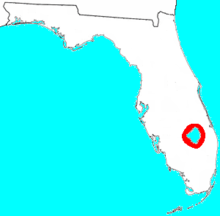Mayaimi

The Mayaimi (also Maymi, Maimi) were
extinction.[1] The linguist Julian Granberry states that the language of the Calusa, Mayaimi (which he calls Guacata) and Tequesta people is related to the Tunica language.[2] The current name, Okeechobee, is derived from the Hitchiti word meaning "big water".[3] The Mayaimis have no linguistic or cultural relationship with the Miami people of the Great Lakes region.[1] The city of Miami is named after the Miami River, which derived its name from Lake Mayaimi.[3]
History
The Mayaimis built ceremonial and village
mound builders. Fort Center is in the area occupied by the Mayaimis in historic times. They dug many canals as other earthworks, to use as pathways for their canoes. The dugout canoes were a platform type with shovel-shaped ends, resembling those used in Central America and the West Indies, rather than the pointed-end canoes used by other peoples in the southeastern United States
.
coontie
for flour. In high-water season they lived on their mounds and ate only fish.
At the beginning of the 18th century, raiders from the
Spanish missionaries sent to Biscayne Bay reported that a remnant of the Mayaimis (which they called Maimies or Maymíes) were part a group of about 100 people, which also included Santaluzos and Mayaca people, still lived four days north of the Miami River.[6][7] Any survivors were presumed to have been evacuated to Cuba when Spain lost control of Florida in the Treaty of Paris
in 1763.
Several archaeological sites are known from the area occupied by the Mayaimi, including Fort Center, Belle Glade, Big Mound City, the Boynton Mounds complex, Ortona Prehistoric Village, and Tony's Mound.[8]
Notes
References
- Austin, Daniel W. (Summer–Fall 1997). "The Glades Indians and the Plants they Used: Ethnobotany of an Extinct Culture" (PDF). The Palmetto. 17 (2): 7–11. Archived from the original (PDF) on 2006-05-25. Retrieved September 13, 2018..
- Hann, John H. (Fall 1995). "Demise of the Pojoy and Bomto". The Florida Historical Quarterly. 74 (2): 184–200. JSTOR 30148820. Retrieved September 13, 2018.
- Douglas, Marjory Stoneman. 1947. The Everglades: River of Grass. Hurricane House Publishers, Inc.
- McGoun, William E. (1993). Prehistoric Peoples of South Florida. Tuscaloosa, Alabama: The University of Alabama Press. ISBN 0-8173-0686-2.
- Simpson, J. Clarence (1956). Mark F. Boyd (ed.). Florida Place-Names of Indian Derivation. Tallahassee, Florida: Florida Geological Survey.
- Sturtevant, William C. (1978) "The Last of the South Florida Aborigines", in Jeral Milanich and Samuel Proctor, Eds. Tacachale: Essays on the Indians of Florida and Southeastern Georgia during the Historic Period, The University Presses of Florida. ISBN 0-8130-0535-3
